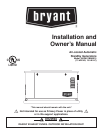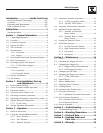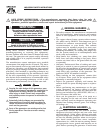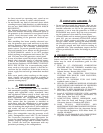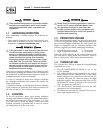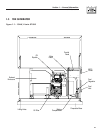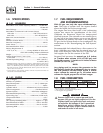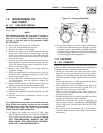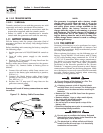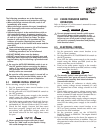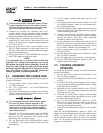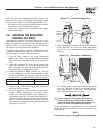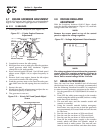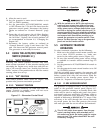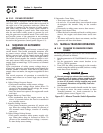
Section 1 — General Information
15 kW Generator
6
1.6 SPECIFICATIONS
1.6.1 GENERATOR
Rated Max. Cont. Power Capacity (Watts*) ..... 13,000 NG/
15,000 LP†
Rated Voltage....................................................... 120/240
Rated Max. Continuous Load Current (Amps)
120 Volts + ......................................108.3 NG/125.0 LP
240 Volts ..............................................54.2 NG/62.5 LP
Main Line Circuit Breaker ....................................65 Amp
Phase .............................................................................1
Number of Rotor Poles ...................................................2
Rated AC Frequency ................................................60 Hz
Power Factor .................................................................. 1
Recommended Air Filter ...........................Part # 0C8127
Battery Requirement at
-17.8° C (0° F) ....................... Group 26/26R 12 Volts and
525 Cold-cranking Amperes Minimum
Weight ........................................................... 487 Pounds
Output Sound Level @ 23 ft (7m)
at full load ................................................... 71.5 db (A)
Normal Operating Range ........................... -20°F (-28.8°C)
to 104°F (40°C)
* Maximum wattage and current are subject to and limited by such factors
as fuel Btu content, ambient temperature, altitude, engine power and con-
dition, etc. Maximum power decreases about 3.5 percent for each 1,000
feet above sea level; and also will decrease about 1 percent for each 6° C
(10° F) above 16° C (60° F).
+ Total current in two separate circuits. Current in each circuit must not
exceed the value stated for 240V.
1.6.2 ENGINE
Type of Engine ......................................................GT-990
Number of Cylinders ...................................................... 2
Rated Horsepower ..................................30 @ 3,600 rpm
Displacement ..........................................................992cc
Cylinder Block .....................Aluminum w/Cast Iron Sleeve
Valve Arrangement ..................................Overhead Valves
Ignition System ..............................Solid-state w/Magneto
Recommended Spark Plug .................................. RC12YC
Spark Plug Gap ............................0.508 mm (0.020 inch)
Compression Ratio ...................................................9.5:1
Starter .................................................................... 12Vdc
Oil Capacity Including Filter.................... Approx. 1.7 Qts
Recommended Oil Filter ...........................Part # 070185
Recommended Air Filter ...........................Part # 0C8127
Operating RPM ........................................................3,600
1.7 FUEL REQUIREMENTS
AND RECOMMENDATIONS
With LP gas, use only the vapor withdrawal sys-
tem. This type of system uses the vapors formed
above the liquid fuel in the storage tank.
The engine has been fitted with a fuel carburetion
system that meets the specifications of the 1997
California Air Resources Board for tamper-proof
dual fuel systems. The unit will run on natural gas or
LP gas, but it has been factory set to run on natural
gas. Should the primary fuel need to be changed to
LP gas, the fuel system needs to be reconfigured. See
instructions in the “Reconfiguring the Fuel System”
section.
Recommended fuels should have a Btu content of at
least 1,000 Btus per cubic foot for natural gas; or at
least 2,520 Btus per cubic foot for LP gas. Ask the
fuel supplier for the Btu content of the fuel.
Required fuel pressure for natural gas is 5 inches
to 7 inches water column (0.18 to 0.25 psi); and
for liquid propane, 11 inches to 14 inches of water
column (0.4 to 0.5 psi).
NOTE:
Any piping used to connect the generator to the
fuel supply should be of adequate size to ensure
the fuel pressure NEVER drops below 4 inches
water column for natural gas or 10 inches water
column for liquid propane for all load ranges.
1.8 FUEL CONSUMPTION
* Natural gas is in cubic feet per hour.
** LP is in gallons per hour/cubic feet per hour.
*** Values given are approximate.
DANGER
Gaseous fuels such as natural gas and liquid
propane (LP) gas are highly explosive. Even the
slightest spark can ignite such fuels and cause
an explosion. No leakage of fuel is permitted.
Natural gas, which is lighter than air, tends to
collect in high areas. LP gas is heavier than air
and tends to settle in low areas.
Model # Nat. Gas (*) LP Vapor (**)
1/2 Load Full Load 1/2 Load Full Load
05207 156 220 1.58/58 2.40/88



